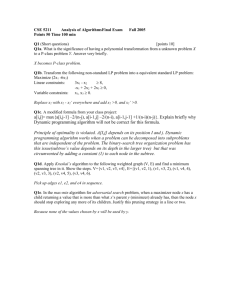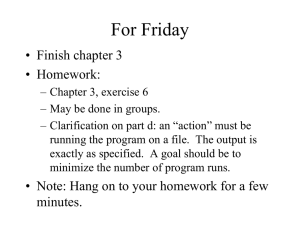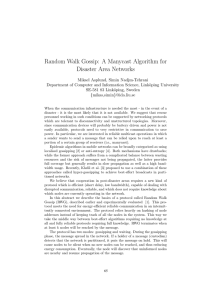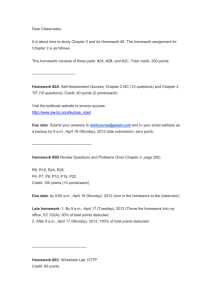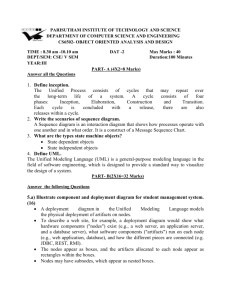Second Exam Questions
advertisement
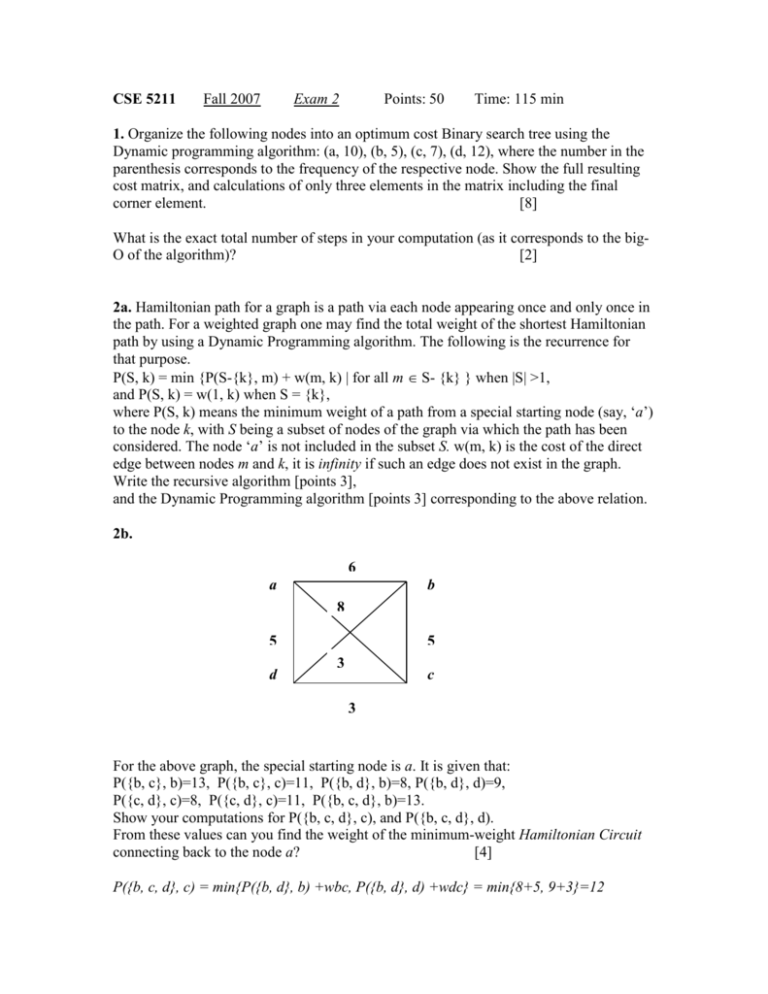
CSE 5211
Fall 2007
Exam 2
Points: 50
Time: 115 min
1. Organize the following nodes into an optimum cost Binary search tree using the
Dynamic programming algorithm: (a, 10), (b, 5), (c, 7), (d, 12), where the number in the
parenthesis corresponds to the frequency of the respective node. Show the full resulting
cost matrix, and calculations of only three elements in the matrix including the final
corner element.
[8]
What is the exact total number of steps in your computation (as it corresponds to the bigO of the algorithm)?
[2]
2a. Hamiltonian path for a graph is a path via each node appearing once and only once in
the path. For a weighted graph one may find the total weight of the shortest Hamiltonian
path by using a Dynamic Programming algorithm. The following is the recurrence for
that purpose.
P(S, k) = min {P(S-{k}, m) + w(m, k) | for all m S- {k} } when |S| >1,
and P(S, k) = w(1, k) when S = {k},
where P(S, k) means the minimum weight of a path from a special starting node (say, ‘a’)
to the node k, with S being a subset of nodes of the graph via which the path has been
considered. The node ‘a’ is not included in the subset S. w(m, k) is the cost of the direct
edge between nodes m and k, it is infinity if such an edge does not exist in the graph.
Write the recursive algorithm [points 3],
and the Dynamic Programming algorithm [points 3] corresponding to the above relation.
2b.
6
a
b
8
5
d
5
3
c
3
For the above graph, the special starting node is a. It is given that:
P({b, c}, b)=13, P({b, c}, c)=11, P({b, d}, b)=8, P({b, d}, d)=9,
P({c, d}, c)=8, P({c, d}, c)=11, P({b, c, d}, b)=13.
Show your computations for P({b, c, d}, c), and P({b, c, d}, d).
From these values can you find the weight of the minimum-weight Hamiltonian Circuit
connecting back to the node a?
[4]
P({b, c, d}, c) = min{P({b, d}, b) +wbc, P({b, d}, d) +wdc} = min{8+5, 9+3}=12
P({b, c, d}, d) = min{P({b, c}, b) +wbd, P({b, c}, c) +wcd} = min{13+3, 11+3}=14
costTSP=min{P({b, c, d}, b) +wba, P({b, c, d}, c) +wca, P({b, c, d}, d) +wda} =
min{13+6, 12+8, 14+5} = 19
3. G is a directed graph (V, E), where E = {(a, b), (b, c), (b, d), (b, e), (c, d), (d, a), (d. g),
(e, f), (f, g), (g, e)}, and the set of nodes is V. Draw it. Use the Strong-connected
component (SCC)-finding algorithm to detect the SCCs of the graph. You must show the
respective DFS-spanning trees along with the corresponding numbers on the nodes as the
algorithm assigns. Suggestion: Use lexicographic order (a <…< g) of the nodes, while
running DFS, so that it becomes easier for me to compare between students’ answers.
[10]
4. Develop a Huffman coding over the following node-frequency pairs by dry running the
Greedy Huffman algorithm. The intermediate forest from each iteration must be shown.
(a, 10), (b, 3), (c, 7), (d, 12), (e, 5).
[10]
5a. Answer true/false (or very briefly) for the following statements.
[5]
a. The set of NP-class problems and the set of NP-complete problems have non-null
intersection.
True
b. It is known that the set of NP-class problems is a proper superset of the P-class
problems.
False
c. Linear Programming is a NP-hard problem.
False
d. X is a newly identified problem, and the problem Y has a polynomial algorithm. There
exists a polynomial transformation from the problem X to the problem Y. What can you
conclude about the complexity of X?
X is P-class
e. 4-SAT is a P-class problem.
False
5b. Transform the following SAT problem to a 3-SAT problem.
C ={{~a}, {~b}, {a, b}, {a, ~b, c, d, ~e, f, ~g}}.
[3+2]
C-3sat ={{~a, x1, x2}, {~a, ~x1, x2}, {~a, x1, ~x2}, {~a, ~x1, ~x2},
{~b, x3, x4}, . . .,
{a, b, x5}, {a, b, ~x5},
{a, ~b, x6}, {~x6, c, x7}, {~x7, d, x8}, {~x8, ~e, x9}, {~x9, f, ~g}}
Show that for the assignment (a=T, b=F, C=T, d=T, e=F, f=T, g=F) the truth value of
your transformation is preserved.
C = F, for {~a}
C-3sat = F, for all of {~a, x1, x2}, {~a, ~x1, x2}, {~a, x1, ~x2}, {~a, ~x1, ~x2} cannot be
made T with any simultaneous assignment of the variables (a=T, x1=T/F, x2=T/F).




